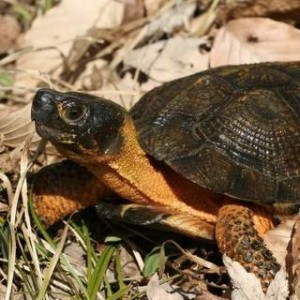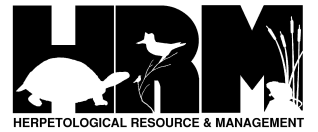Wood Turtle
Overview:
Scientific Name: Glyptemys insculpta
Size: 6.3 – 9.8” (adult carapace length)
Status: Generally uncommon to rate across Great Lakes range. Many local populations have experienced great reductions or extirpation due to human activities. Species can be locally common where habitat intact and disturbance is low.

Habitat:
Most common in or near sandy-bottomed streams or rivers, but also occur in streams with partially rocky or silty beds. Largely aquatic during most of the year but are often terrestrial during summer, and can be found walking through woodlands, alder thickets, swamps, wet meadows, and fields within or near floodplain.
Adult Coloration:
Carapace brown or grayish brown, sometimes with pattern of radiating yellow and black lines on vertebral and pleural scutes. Plastron yellow with dark blotch at rear outer corner of each scute. Head and upper neck, legs and tail black. Lower neck, legs, tail, and other soft parts vary from yellow to yellowish orange.
Adult Characteristics:
Carapace with low central keel and well-defined growth rings (annuli) crossed by ray-like ridges on scutes. V-shaped notch in plastron at tail. Males with higher, narrower shells, larger, wider heads, and more robust limbs and feet with thick claws. Tail also longer and thicker in males than females. Males can also be distinguished by a concave plastron. Females have broader and less domed carapace with rear marginal scutes outwardly flared. Immature males may be mistaken for females when less than about 6.3” carapace length.
Juvenile Characteristics:
Hatchlings are uniform gray, tan, or brown color, with nearly circular carapaces and long, thin tails. Range from 1.1 – 1.5” carapace length. Typical adult color pattern usually acquired during first full year of growth.
Species Confused With:
Blanding’s Turtles are also yellow under neck and legs and have similar plastral pattern, but they have a hinged plastron and an unkeeled, domed carapace. .
References:
- Amphibians and Reptiles of the Great Lakes Region by Jim Harding
- Harding, J.H. and J.A. Holman. 1990. Michigan Turtles and Lizards. MSU Cooperative Extension Service and MSU Museum. 96 pp.
- Ruthven, A. G., H. B. T. Gaige, et al. 1912. The herpetology of Michigan, by Alexander B. Ruthven. Crystal Thompson and Helen Thompson; Memoranda towards a bibliography of the archaeology of Michigan, by Harlan I. Smith; prepared under the direction of Alexander G. Ruthven. Lansing, Mich., Wynkoop Hallenbeck Crawford, State Printers.
- Holman, J. A. 2012. The Amphibians and Reptiles of Michigan: A Quaternary and Recent Faunal Adventure. Detroit, Mich., Wayne State University Press.
- Conant, R., and Collins, J. T. 1998. Reptiles and Amphibians: Eastern, Central North America. Houghton Mifflin Harcourt Press.
Credits:
- Jim Harding
